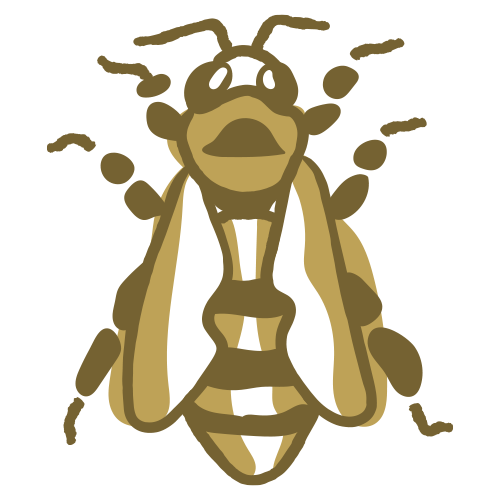
(Apis mellifera)
The European Honey Bee
WORKER BEES
Worker bees are always female, and are responsible for all of the pollinating and honey making. The workers have several jobs throughout their short lives, starting from the least dangerous: nursing young brood, attending the queen, cleaning the hive, undertaking dead bees. Before they graduate to the more dangerous jobs: guarding the hive entrance, scouting, foraging for nectar and pollen. Worker bees do not mate with drones and therefore cannot lay fertilized eggs, though sometimes when a hive goes queenless for extended time they will lay unfertilized drone eggs in what’s called a “laying worker hive”. This usually ends in the demise of the colony, even if a new queen is introduced at this point the bees loyal to the laying worker will kill her.
DRONE BEES
Drones are the large, round looking male bees inside of the hive. They don’t sting, forage, or make honey. Their sole purpose is to gather in large numbers high up in the air in what are called “drone congregation areas” or “DCA’s” and wait for a virgin queen from a distant colony to come along. The queen will mate mid-flight with up to 20 drones at once from all different hives before returning to her own colony miles away; this ensures genetic variation in her egg laying. Queens also tend to fly farther to DCA’s than their drone counterparts, ensuring that queens do not mate with their sibling drones. Those lucky enough to mate with a queen will die in the process, and the rest of the drones will be expelled from the hive before winter so as not to use up precious resources.
THE QUEENBEE
The queen is the only bee with fully developed reproductive organs and stores enough sperm from multiple drone hosts to last her entire life span of up to 6 years. She will cover the entire brood laying area daily, laying eggs in empty cells, up to 2,000 per day. Queens exhibit an audible trait called piping, which is most common in newly emerged virgin queens. It is this battlecry that helps them to locate each other and fight to the death. Unlike the workers, queens don’t have barbs on their stingers, which enables them to sting repeatedly. However they only sting other queens, even those that have not yet hatched. There is usually only 1 queen in a hive. You can identify her by her narrow, elongated thorax. Don't mistake her for a drone, which are larger than worker bees but with more rounded bodies than a queen. A good way to locate the queen is by watching the bees directly around her move out of her way while facing towards her; sometimes feeding her and cleaning up her waste as she goes from cell to cell.

MORE BEE FACTS!?
-
All bees start out as either a fertilized egg (females) or an unfertilized egg (males); any fertilized egg can become a queen. The difference between a queen and a worker is the diet during the larval stage of development; a queen being fed exclusively on royal jelly. After 3 days, the eggs hatch into larvae and are fed a diet of royal jelly, pollen, and honey. After about 6 more days, workers will then cap the larvae to allow them to transform into pupa and finally hatch out as young adult bees. The cappings of the brood are brown and porous, and allow for the cocoon to breath, this differs from capped honey which is capped with smooth, white beeswax. Drone cells are larger and stick out further than typical worker cells. Queen cells are the largest, very elongated and fairly obvious, resembling a peanut hanging off the frame. Queens will hatch faster than workers and workers will hatch faster than drones. The entire process from egg to hatching takes about 16-24 days depending. The brood is typically centralized in the frames. If imagining a 3D model of a beehive cluster it would look like a basketball encompassed by pollen and honey.
-
Bee’s use pheromones to communicate and manage their insect societies. A pheromone is a chemical signal that bee’s produce to affect the behavior or physiology of other bees; nearly every colony activity from hive defense, swarming, supersedure, beeswax production etc. Field bees produce pheromone which slows the maturation of nurse bees so that the ratio of nurse and forager bees is optimized. Uncapped brood pheromone causes nurse bee’s to excrete royal jelly from glands in their heads. Mated queens produce a pheromone that inhibits the development of ovaries in the workers, and prevents them from raising new queens… Their defense pheromone, well known to beekeepers, smells distinctly like bananas, and is released when the stinger is pulled from the abdomen of the honeybee while releasing her venom and causing surrounding bee’s to attack as well.
-
The “waggle dance” is used by forager bees to communicate the location of valuable food sources or alluring cavities for new nest sites; it is their method of recruitment, so to speak. If you see a worker bee turning in circles and shaking her butt, she is rallying other bees to this food source or location. That means either nectar producing flowers, weaker hives, or spilled honey in the honey house could become targets for thousands of bees in short time. Not only can they communicate distance and the location of the food source approximate to the angle of the sun, but even the abundance of the source can be communicated by the tempo of the waggle.
-
If you are lucky enough to witness a cloud of honeybees in the sky moving in unison, you are witnessing a swarm of bees. To swarm is to satisfy the reproductive urge of the colony by finding a new location to nest; leaving behind a portion of the colony to carry on with a newly hatched queen. The colony will begin swarm preparations far in advance of their exodus, and it is nearly impossible to stop them once they have started. They begin by scouting for their next location, preferring a cavity of about 40 liters on average. Bees will even use the waggle dance to democratically vote on which nest site to choose ahead of taking flight, so that everyone is heading towards the same location with their queen. The worker bees will prevent the queen from eating or laying eggs, which will cause her to slim down so that she will be flight ready. The field bees will then gorge on honey, taking as much with them as they can. As soon as the new queen cells are capped, and days from hatching, they begin their migration. Swarm season most often occurs during peak brood and nectar production, during May and June in this region. A full strength bee colony can often average 80,000 honeybees during the peak season.
-
Pollen is both intentionally collected by worker bees on their back legs and inadvertently spread around by their fuzzy bodies through the process of pollination. The bees use pollen as a source of protein, mostly consumed for brood rearing. It is typically packed into cells around the outside of the frames, encircling the brood. Nectar is also collected from flowers and is what the bees turn into honey, which they store overwinter for use as energy in the form of carbohydrates. The honey is also stored around the most outer portion of the frames. Bees will sometimes mix pollen and nectar together to create a fermented pollen substance known as “bee bread” which is consumed by nurse bees in order for them to produce royal jelly.
When a honeybee is foraging for nectar it visits dozens of different flowers in one trip, storing the nectar in a second stomach know as a honey sac. The complex sugars from the nectar are broken down by enzymes in the honey sac into fructose and glucose; simple sugars that are easy to digest. The bee travels back to the hive and regurgitates this nectar and enzymes to other bees. They pass this back and forth each time reducing the water content of the nectar, adding enzymes, and converting it into what we know as honey; a process called “inversion”. Once it’s been mostly reduced, the bees will store it in the comb, and continue to evaporate it by fanning it with their wings. Once the comb is filled with honey and its below 18% water content, the honey is finished and capped with beeswax. The low water content of the honey is what prevents fermentation and spoilage, making honey the one natural thing on earth that will last indefinitely. Each honeybee will produce roughly 1/10th of a teaspoon of honey in its lifetime.
-
Royal jelly is a secretion by nurse bees in the presence of open larvae, which they only feed to that larvae. The length of time and amount of royal jelly fed is what transforms a worker larvae into a queen larvae, also extending her life from mere weeks to up to several years. It is composed of water, proteins, sugars, vitamins, trace minerals and enzymes. It appears white and watery and can be seen in the cells with small uncapped larvae.
Propolis is like the cement or building material that bees use to seal the hive together or close up small unwanted spaces. Bees will often collect and deposit it in a pile for later use, sometimes even encasing foreign objects or smoothing rough patches in their home with it. It is produced by mixing bee saliva and beeswax with exudate gathered from tree resins or other botanical sources. Propolis is orange to red in color, and produced most of all in the late summer/ early fall. Propolis has extremely beneficial antimicrobial properties and is a fascinating component of honeybee’s.
Beeswax is secretion produced by the wax glands in a young worker bee’s abdomen. Sugars from honey are converted into wax which secretes through small pores on their abdomen into the form of tiny flakes. These flakes are collected and used to build honeycomb; all of the hexagonal comb within the hive. Bees use about 6 pounds of honey to produce 1 pound of wax. Beeswax starts as pure white in color but is quickly died yellow from use, and eventually black from heavy brood rearing.












